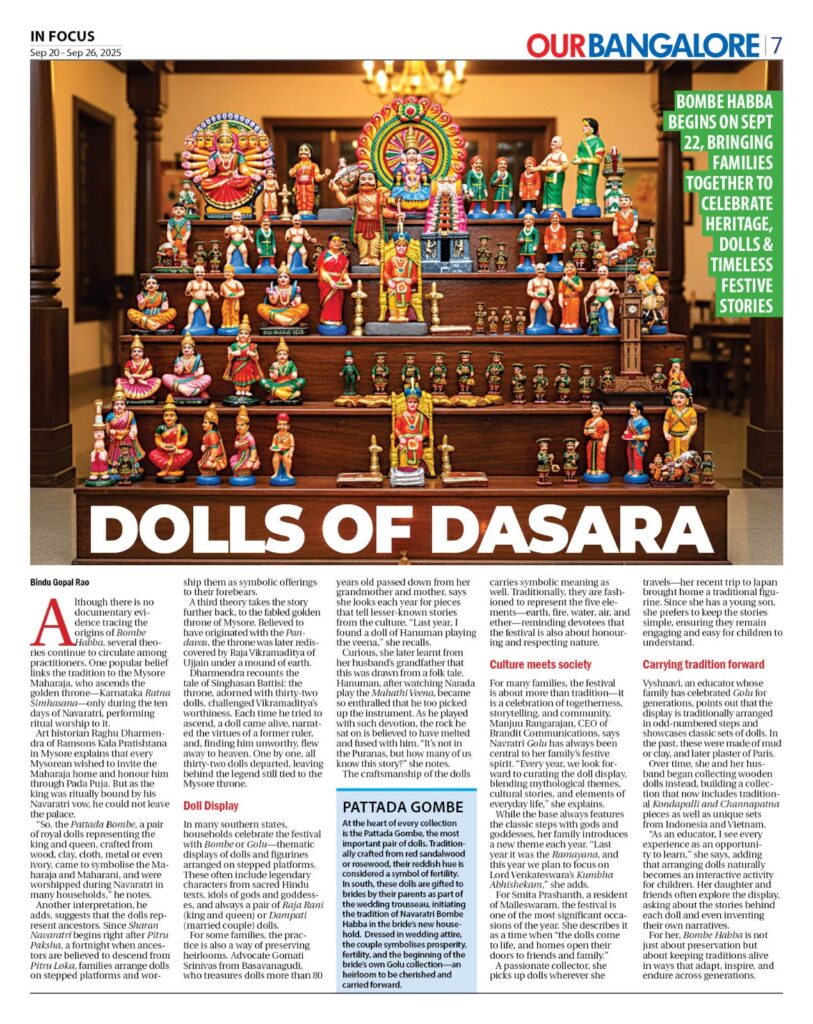
Growing up, Navaratri meant not just arranging the Golu, but also visiting friends and relishing good food at every home.
Interestingly, the festival is celebrated as a huge event in Mysore, a city that is strongly linked with Navratri and Dasara tales along with the Chamudeshwari temple. Chamundeshwari is an avatar of Durga who battled the demon Mahishasura for nine nights and defeated him on the tenth day. The city came to be called as Mahishasurana Uru (meaning, the town that Mahishasura belonged to) and then became Mahisur or Mysuru, and subsequently Mysore.
The Mysore’s Dasara festivities follow a defined manner of devotion mentioned in numerous sacred texts and was popularized by the Vijayanagara Empire. The Goddess is elegantly adorned and ornamented and seated on the most sacred portion of a plain ground, known as the mantapa, which has been equally decorated.
The Devi is worshipped every night during the Navaratri in specification to her various forms. On the tenth day, the Devi is paraded in a procession through the city’s beautifully lit streets, beginning at the illuminated palace and ending at the Bannimantapa Ground, accompanied by horses, elephants, and chariots, and headed by the king himself. The Banni tree, which has its own history, is revered by the royals. The celebration concludes with a torchlight parade in the Bannimantapa ground at evening.
The King of Mysore cannot go out of the Palace during Navaratri until Seemollanghana. A stepped platform, representing the stepped golden throne, is assembled in one of the spacious rooms in the house and the Pattada Bombe are placed on the top-most tier. Other dolls in the form of deities, important personalities, animals, birds and toys are placed on the other steps of this Bombe Mettilu. Usually Bombe Mettilu consists of odd number of steps, say three, five, seven or nine. More number of steps will be added as the doll collection expands over years. So paying respect to the royal couple is the first theory for Bombe Habba. The Bombe Mettilu of Navaratri peopled with the dolls represent this holy throne of Pandavas.
Towns and cities in the southern states celebrate the festival in their homes with Golu. Golu refers to the thematic display of dolls and figurines depicting legendary characters from sacred Hindu texts, idols of gods and goddesses as well as a couple of Raja Rani (King and Queen) or Dampati (married couple) dolls. These are also referred to as Pattada Gombe meaning royal dolls and are typically made of red sandalwood, or rose wood. They are preferred to be slightly red in colour.
Red has always been a symbolic representation of fertility. It is also believed that the original purpose of the Pattada Gombe, sometimes also referred to as “rakta bommai” (rakta meaning blood) was to be rubbed against a rough surface in order to extract a paste that had healing capabilities. Some cultures state that the dolls are deliberately made in red so women during their menstrual cycle can touch them without hesitation. Hence, they are gifted to brides by their parents in southern India during their wedding as an heirloom and a part of wedding trousseau to initiate the yearly tradition of Navaratri Golu in her new home with her new family.
These dolls come as couples dressed in their wedding attire, depicting husband and wife symbolizing prosperity and fertility and the start of the bride’s own Golu collection. Though, this creative tradition can ideally be perceived as a ‘Grihini aesthetic’ as scholars of art and anthropology call it, it is not necessarily limited to housewives. This curated exhibition in itself can be viewed as evidence that represents growth towards that direction.
Read the full story that first appeared in Our Bangalore dated Sep 20-26 2025 here:
A downloadable PDF is here:


Leave a Reply